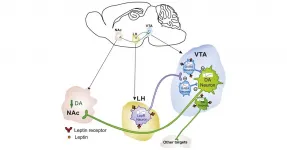New USGS report shows high levels of arsenic and uranium in some wells
Connecticut public health officials urge private well owners to test water quality
2021-04-06
(Press-News.org) A new U.S. Geological Survey study provides an updated, statewide estimate of high levels of naturally occurring arsenic and uranium in private well water across Connecticut. This research builds on a USGS report published in 2017, with the new study including additional groundwater samples and focusing on previously underrepresented areas.
The research, undertaken in cooperation with the Connecticut Department of Public Health, projects that approximately 3.9% of private wells across Connecticut contain water with arsenic at concentrations higher than the U.S. Environmental Protection Agency's maximum contaminant level for public drinking-water supplies. This research also projects that 4.7% of private wells in the state have uranium concentrations higher than the EPA's standards.
CT DPH officials urge all private well owners to have their water tested for possible arsenic and uranium.
Arsenic and uranium are naturally occurring metals in bedrock around the world. Sometimes wells drilled into bedrock aquifers can produce water containing arsenic or uranium. Unless wells are tested, there's no way to confirm the presence or absence of these contaminants.
According to the CT DPH, Centers for Disease Control and Prevention, EPA and other health experts, there are potential health risks when concentrations of arsenic and uranium in groundwater used for drinking are higher than established human-health standards. Arsenic exposure has been related to increased cancer risk, low birth weight, decreased child intellectual development, immune system suppression and other adverse health outcomes. Ingestion of uranium, such as through drinking water, has been associated with kidney disease.
Data from this study can be used to better estimate the number of people potentially affected by high concentrations of naturally occurring arsenic and uranium in water from private wells.
An estimated 23% of Connecticut residents have private wells for their water supply. During the study, the CT DPH, with help from its state laboratory and local health officials, collected and analyzed water samples from more than 2,000 private wells throughout the state. Where high levels of arsenic or uranium were detected, state and local health officials worked with participating residents to inform and assist them with remedial measures to protect their water supply.
"This report provides essential tools to citizens, health officials, well drillers, government officials and others for better protecting their communities and the environment," said Eliza Gross, USGS physical scientist and lead author of the study. "The previous USGS study published in 2017 identified some areas where there were high contaminant levels, and we now have a more complete statewide assessment."
"Even though we know there are areas across our state that have higher concentrations than others, any private well in Connecticut has the potential to have elevated arsenic or uranium," said Ryan Tetreault, CT DPH Private Well Program supervisor. "Private well owners should have their well water tested at least once for these contaminants."
The CT DPH recommends that if tested well water has arsenic at a level greater than federal and state standards, an alternate source of water should be used or a treatment system should be installed. Also, if uranium in well water is at a concentration greater than the EPA standard of 30 micrograms per liter, the water should be treated to remove the uranium.
To ensure accuracy in the assessment, researchers separated Connecticut into grid cells for what's called a "spatially weighted analysis": a process that ensures areas with clusters of samples aren't overrepresented in a statewide estimate.
The USGS also found that certain bedrock types are more likely than others to yield high concentrations of arsenic and uranium in groundwater.
"While bedrock geology is not always predictive of higher or lower concentrations of arsenic or uranium in groundwater, knowing that certain geologic settings have a high likelihood can help inform decisions, such as drilling new wells, planning for development or deciding whether to conduct additional water-quality testing," said Gross. "This insight on geologic settings can also be applied to research in other states."
INFORMATION:
According to the CT DPH, routine testing for private well water does not usually include testing for arsenic and uranium; it is up to private well owners to have their well water additionally tested for these contaminants. The CT DPH also encourages new homebuyers to ask for such testing when purchasing a home with a private well. Under Connecticut law, the local director of health has the authority to require testing for arsenic and uranium in water from newly drilled wells if they have reason to believe there is a problem in their town.
State officials recommend that homeowners with private wells contact an environmental lab approved to test water. A listing of environmental labs approved to test drinking water can be found at https://portal.ct.gov/DPH/Environmental-Health/Environmental-Laboratory-Certification/Environmental-Laboratory-Certification. If testing finds high levels of arsenic, more information about follow-up testing and treatment for arsenic is available at https://portal.ct.gov/-/media/Departments-and-Agencies/DPH/dph/environmental_health/private_wells/Publications/ArsenicPrivateWellWater21.pdf. If testing finds high levels of uranium, more information about treatment is available at https://portal.ct.gov/-/media/Departments-and-Agencies/DPH/dph/environmental_health/private_wells/2018-Downloads/050818-uranium_in_well_water_September_2016.pdf.
Read the full study titled, Arsenic and Uranium Occurrence in Private Wells in Connecticut, 2013-18--A Spatially Weighted and Bedrock Geology Assessment, at https://doi.org/10.3133/ofr20201111.
Learn more about USGS arsenic research in New England at https://www.usgs.gov/centers/new-england-water/science-topics/arsenic-0.
More information about private well testing in Connecticut can be obtained from the DPH Private Well Program website at https://portal.ct.gov/dph/Environmental-Health/Private-Well-Water-Program/Private-Wells#48151. The DPH also has a website with resources on how to make private well water safer at https://testyourwell.ct.gov/. For related questions, contact the DPH Private Well Program at dph.privatewellprogram@ct.gov or (860) 509-8401.
For health-related questions, contact the DPH Environmental & Occupational Health Assessment Program at dph.eoha@ct.gov or (860) 509-7740. Their website is mailto:DPH%20Environmental%20&%20Occupational%20Health%20Assessment%20Program.
[Attachments] See images for this press release:

ELSE PRESS RELEASES FROM THIS DATE:
2021-04-06
Sea urchins receive a lot of attention in California. Red urchins support a thriving fishery, while their purple cousins are often blamed for mowing down kelp forests to create urchin barrens. Yet for all the notice we pay them, we know surprisingly little about the microbiomes that support these spiny species.
Researchers at UC Santa Barbara led by geneticist Paige Miller sought to uncover the diversity within the guts of these important kelp forest inhabitants. Their results reveal significant differences between the microbiota of the two species, as well as between individuals living ...
2021-04-06
Philadelphia, April 6, 2021 - Since the discovery of leptin in the 1990s, researchers have wondered, how does leptin, a hormone made by body fat, suppress appetite? Despite tremendous gains in the intervening three decades, many questions still remain. Now, a new study in mice describes novel neurocircuitry between midbrain structures that control feeding behaviors that are under modulatory control by leptin. The study appears in Biological Psychiatry, published by Elsevier.
John Krystal, MD, Editor of Biological Psychiatry, said of the findings, "Omrani and colleagues shed light on how, in non-obese animals, leptin puts the brakes on overeating."
Leptin acts as a critical link between the body and the brain, providing information about metabolic ...
2021-04-06
In addition to smoothing out wrinkles, researchers have found that the drug Botox can reveal the inner workings of the brain. A new study used it to show that feedback from individual nerve cells controls the release of dopamine, a chemical messenger involved in motivation, memory, and movement.
Such "self-regulation," the researchers say, stands in contrast to the widely held view that the release of dopamine -- known as the "feel good" hormone -- by any cell relied on messages from nearby cells to recognize that it is releasing too much of the hormone.
Led by researchers at NYU Grossman School of Medicine, ...
2021-04-06
WASHINGTON, April 6, 2021 -- Scientists from MIT and the Indian Institute of Technology Madras have grown small amounts of self-organizing brain tissue, known as organoids, in a tiny 3D-printed system that allows observation while they grow and develop. The work is reported in Biomicrofluidics, by AIP Publishing.
Current technology for real-time observation of growing organoids involves the use of commercial culture dishes with many wells in a glass-bottomed plate placed under a microscope. The plates are costly and only compatible with specific microscopes. They do not allow for the flow or replenishment of a nutrient medium to the growing tissue.
Recent advances have used a technique known as microfluidics, where a nutrient ...
2021-04-06
WASHINGTON, April 6, 2021 -- Cryocoolers are ultracold refrigeration units used in surgery and drug development, semiconductor fabrication, and spacecraft. They can be tubes, pumps, tabletop sizes, or larger refrigerator systems.
The regenerative heat exchanger, or regenerator, is a core component of cryocoolers. At temperatures below 10 kelvins (-441.67 degrees Fahrenheit), performance drops precipitously, with maximum regenerator loss of more than 50%.
In their paper, published in Applied Physics Letters, by AIP Publishing, researchers at the University of Chinese Academy of Sciences used ...
2021-04-06
WASHINGTON, April 6, 2021 -- Dragonfly wings, lotus leaves, cicada wings -- thanks to millennia of evolution, nature has optimized the ways these surfaces and others behave to offer antibacterial functionality.
An international, interdisciplinary team of researchers is trying to find the best way to translate these features to create nature-inspired bactericidal surfaces for use in medical implants. They discuss the surface structures and chemical compositions for an ideal implant material in the journal Applied Physics Reviews, from AIP Publishing.
"Objects in ...
2021-04-06
What The Study Did: Researchers compared the effectiveness of case-based (including contact tracing and quarantine) and population-based (including social distancing and facial masking) interventions for COVID-19 containment in Taiwan, one of the few countries with initial success in COVID-19 control without strict lockdown or school closure.
Authors: Hsien-Ho Lin, M.D., Sc.D., of National Taiwan University in Taipei, Taiwan, is the corresponding author.
To access the embargoed study: Visit our For The Media website at this link https://media.jamanetwork.com/
(doi:10.1001/jamainternmed.2021.1644)
Editor's Note: The article includes conflicts of interest and funding/support disclosures. Please see the article for additional information, including ...
2021-04-06
What The Study Did: This study investigated the role of droplet or contact transmission in the development of Kawasaki disease in Japan during the COVID-19 state of emergency. Kawasaki disease primarily affects children and is characterized by fever and swelling in the walls of some blood vessels.
Authors: Toshiro Hara, M.D., Ph.D., of the Fukuoka Children's Hospital in Fukuoka, Japan, is the corresponding author.
To access the embargoed study: Visit our For The Media website at this link https://media.jamanetwork.com/
(doi:10.1001/jamanetworkopen.2021.4475)
Editor's Note: The article includes conflicts of interest and funding/support disclosures. Please see the article for additional information, ...
2021-04-06
What The Study Did: A model to prioritize vaccination was developed that estimates the risk of SARS-CoV-2-related death among enrollees in the Veterans Affairs health care system.
Authors: George N. Ioannou, B.M.B.Ch., M.S., of the Veterans Affairs Puget Sound Healthcare System in Seattle, is the corresponding author.
To access the embargoed study: Visit our For The Media website at this link https://media.jamanetwork.com/
(doi:10.1001/jamanetworkopen.2021.4347)
Editor's Note: The article includes conflicts of interest and funding/support disclosures. Please see the article for additional information, including other authors, author contributions and affiliations, conflict of interest and financial disclosures, and funding and support.
INFORMATION:
Media ...
2021-04-06
What The Study Did: The clinical and other characteristics of multisystem inflammatory syndrome in children in the United States, a condition that occurs in association with the COVID-19 pandemic, are described in this study.
Authors: Ermias D. Belay, M.D., of the Centers for Disease Control and Prevention in Atlanta, is the corresponding author.
To access the embargoed study: Visit our For The Media website at this link https://media.jamanetwork.com/
(doi:10.1001/jamapediatrics.2021.0630)
Editor's Note: The article includes conflict of interest ...
LAST 30 PRESS RELEASES:
[Press-News.org] New USGS report shows high levels of arsenic and uranium in some wells
Connecticut public health officials urge private well owners to test water quality



